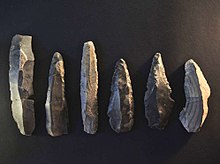Rijckholt flint
Rijckholt flint (also called Maasfeuerstein) is the most common flint found on Neolithic sites in the Benelux countries and the Rhineland . This is particularly true of the older and middle band ceramics (5500-5200 BC) and the early Neolithic. Rijckholt-Feuerstein takes its name from the town of the same name south of Maastricht in the Dutch province of Limburg . The mines were discovered by Marcel De Puydt in 1881 and excavated from 1923.
There are the Maasfeuerstein varieties: Hellgraubelgischer-, Lousberg-, Maasschotter-, Maaseier-, Obourg-, Rijckholt-, Rullen, Simpelveld-, Spiennes-, Valkenburg- and Vetschau- or Orsbach-Feuerstein.
history
From a geological point of view, the flint comes from layers of the Maastrich chalk 500 m east of Rijckholt. The raw material was extracted in the open pit. In the district of St. Geertuid existed between about 3950 and 2650 BC. BC in an area of eight hectares of mines in which the flint was extracted from shafts five to twelve meters deep.
The total production of Rijckholt-Feuerstein is estimated at 19,500 to 23,000 tons over the life of the mines. Mainly blades , large scrapers and preliminary products for ax blades were manufactured from the flint . It is estimated that around 25,000 blades or axes per year would be 12.5 million flint products over the period of use.
In the mining area, archaeologists dug some shafts and connected them with horizontal tunnels. It turned out that the Neolithic miners were essentially targeting layer 10 of the 23 flint-containing layers in the limestone , which provided the highest quality. The stones from layer 10 are bulbous. Their diameter is at least 20 cm. The tubers have a variety of shape and color of the inclusions visible to the naked eye and of texture , which is predominantly fine-grained. The color, sometimes with a slight shimmer of blue, varies from dark to light gray. The darkest areas can be "glass-like"; that is, they are somewhat translucent, which is particularly noticeable on the edges of blades and tees . By far most of the material is opaque . The gap surface is not shiny, but smooth.
Felder, Rademakers and de Grooth gave an extensive description of the Rijckholt flint. Blades that can be shown to come from a core stone were found in depots in the mining area, but also far away. The semi-finished hatchet blades were trimmed and ground by the end user. It is impossible to clearly distinguish Rijckholt-Feuerstein mined from that from Spiennes or Jandrain-Jandrenouilles.
literature
- Peter J. (Sjeuf) Felder, P. Cor M. Rademakers, Marjorie E.Th. de Grooth (Ed.): Excavations of prehistoric flint mines at Rijckholt-St. Geertruid (Limburg, The Netherlands) by the “Prehistoric Flint Mines Working Group” of the Dutch Geological Society, Limburg Section (= Archaeological Reports. 12). Published by the German Society for Prehistory and Early History eV Habelt in commission, Bonn 1998, ISBN 3-7749-2907-6 , ( online ).
- Karl Reger: The prehistoric flint pits of Rijkholt-Sint Geertruid. In: 6th International Mining Workshop. Rescheid / Eifel 1st to 5th October 2003. Proceedings. Heimatverein Rescheid, Hellenthal / Eifel 2003, pp. 94-100.

